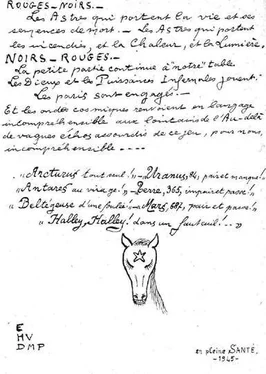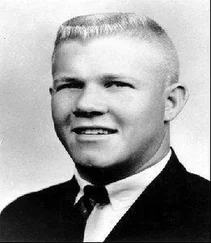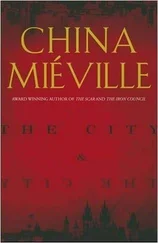“A good colleague,” Massu said, “profited from the circumstances to settle in my chair at the head of the Brigade Criminelle.” Massu would return to the police force to serve with distinction. On his retirement in 1947, he went to work in security at the American Embassy in Paris.
Eleven years later, Massu appeared in a French television documentary together with his old friend, the bestselling mystery writer Georges Simenon. The two of them reminisced about how they first met over a glass of red wine at Les Trois Marches. Simenon described how, for inspiration, he had “haunted the Palais de Justice, the Place de Dauphine, [and] the little corner cafes.” He elaborated:
I took all my models from right here. I watched them at work, and I picked up their habits. Maigret is a little of Chief Inspector Massu, a little of Chief Inspector Guillaume [Massu’s former supervisor]
.
Commissaire Massu lives on today in Simenon’s gruff, earthy fictional detective Jules Amédée François Maigret.
23.
INTERROGATIONS
AN INDIVIDUAL WITHOUT SCRUPLES AND DEVOID OF ALL MORAL SENSIBILITY.
—Dr. Claude, Dr. Laignel-Lavastine, and
Dr. Génil Perrin on Marcel Petiot
AS Captain Simonin later revealed, he had discovered Marcel Petiot’s exact whereabouts thanks to a tip from one of Petiot-Valeri’s subordinates at the Reuilly armory. FFI Corporal Jean-Richard Salvage told him that the suspect was staying in an apartment owned by his mother at 22 rue Paul-Bert. Simonin had investigated the lead. Sure enough, Petiot left the building every morning, took the métro at Saint-Mandé-Tourelle station, and exited at Reuilly-Diderot for a quick walk to the armory.
After making the arrest, Simonin did not immediately hand Petiot over to the police. Instead, he decided to question him about his activities. From the beginning, Petiot took on a brash, condescending tone, claiming to be, as Simonin put it, “a hero of the Resistance.” He bandied about the terminology of the Communist Party, blasting the “hirelings of the capitalists” and “mercenaries in the service of the Americans.” He spoke vaguely about only “obeying orders” and implied that his comrades in “the party” would not hesitate to free him.
According to Simonin’s account of the interrogation, which eventually ended up in the files of the Paris police, Petiot elaborated on his many alleged services for the Resistance. He identified himself as an investigations officer and captain in the First Infantry Regiment of the FFI based at Reuilly. Later Simonin would say that he believed Petiot had chosen to apply to this particular armory because of the prominence of several Communist leaders there, including Commandant Raffy, a former ranking member of the Resistance group FTP (Franc-Tireurs et Partisans), who would serve as Petiot’s supervisor at Reuilly. It is also significant that Reuilly—so recently evacuated by the Germans—was also taking a lead in forming the tribunals to purge former collaborators.
Petiot denied that he had revealed his real name when he arrived at the armory in September 1944 looking for a commission. He presented himself, he said, as Dr. Wetterwald, who in turn used the alias Dr. Valeri. Simonin later said that he was positive that Petiot was lying. Petiot would only admit that he believed that Raffy’s own boss, the head of the First Infantry Regiment, Colonel Ruaux, knew his true identity. In time, Petiot added, other people at the armory learned about his past. He defended them by pointing out that they had not put much credence in the wild slanders of the German press.
After discussing his medical practice, which he said earned 500,000 francs a year, an ironic boast perhaps for an avowed Communist, Petiot told Simonin that he had begun working for the Resistance in 1941. He had used his work as a physician to “demoralize German officer patients who came to consult me.” He made contact with a Resistance organization based on rue Cambon, to send him French workers who had returned ill or wounded from their work in Germany. These Frenchmen, Petiot said, often provided “very interesting intelligence,” which he readily passed on to the Allies.
Petiot mentioned specifically informing the American consulate in Paris about a secret German weapon, based on the principle of the boomerang, that was being developed just over forty miles southwest of Berlin. He identified his contact at the consulate as a man named Thompson. The American consul was Tyler Thompson, but he would later deny having any contact with the suspect. As for how Petiot could have known his name, Thompson had a theory. At the beginning of the Occupation, when he served as third secretary, Thompson had signed more than one thousand red certificates to be placed on American-owned buildings and businesses all over Paris, declaring them inviolable according to international law.
By late 1941, Petiot had allegedly made many more contacts in the Resistance. He claimed to be working with a group of anti-Franco Spaniards in the outlying district of Levallois and receiving training from a man from London who organized Resistance in Franche-Comté. Who was this British agent? Petiot said that he never knew his name, or even his code name. He did mention working with a man called “Cumulo,” who operated the Resistance group Arc-en-Ciel, which in turn served under Pierre Brossolette in Charles de Gaulle’s intelligence service, the BCRA.
There were already many allegations to investigate, and authorities would pursue them, but Petiot was not done talking. As in the letter to Résistance , Petiot described how he had worked for a supposed Resistance group, “Fly-Tox,” that specialized in tracking down and executing informers, or mouchards , a slang term derived from the French word for fly ( mouche ). The name “Fly-Tox,” Petiot later said, had been inspired by a commercial fly-killer product because, like the pesticide, his men liquidated mouchards .
When Simonin asked Petiot to provide names “and all the information in your possession” about members of his alleged group, Petiot replied calmly that his organization was well known and it was unnecessary to provide further details. He did, however, elaborate on Fly-Tox’s methods of operation.
Members of his organization staked out the offices of the Gestapo on rue des Saussaies. Any civilian who left the premises was followed. The Fly-Tox Resistant, posing as a member of the German secret police, waited until the target went to a secluded spot and then seized him. If the latter protested that he worked for the Germans, he had, as Petiot later put it, “convicted himself.” The suspect was then thrown into a truck. Interrogations took place at his property on rue Le Sueur, which he had used since his purchase earlier that year to store his antiques and “the bulk of his fortune.”
The suspected collaborator—“once we acquired the certainty of his guilt”—would be executed by revolver or a secret weapon that Petiot claimed to have invented, which could fire in silence up to one hundred feet with deadly accuracy. The bodies were then dumped in the forests of either Marly-le-Roi or Saint-Cloud. Petiot claimed to have killed sixty-three people this way. As for the exact place his group disposed of the bodies, he said that he could not remember. He did not know the names of his victims either, as he had not recorded them and often could not determine with any certainty if his men knew a suspect’s true identity. “We only knew that they were enemies who had to disappear.”
In December 1941, when the United States entered the war, Petiot claimed to have offered the design of his secret weapon to the American consulate (and this was also when he first adopted the pseudonym Dr. Eugène). By this time, Fly-Tox was supposedly managing a clandestine organization that helped Frenchmen escape Occupied Paris. False papers were obtained from a man close to Lucien Romier, Vichy minister of state, and another person known as “Desaix,” or more probably “De C,” who served the embassy of the Argentine Republic. A police commissaire based in the 7th arrondissement of Lyon further helped Petiot’s clients cross the border. The identification documents allowed Frenchmen to cross into Spain, then Portugal, and from there, reach safety in Argentina.
Читать дальше












